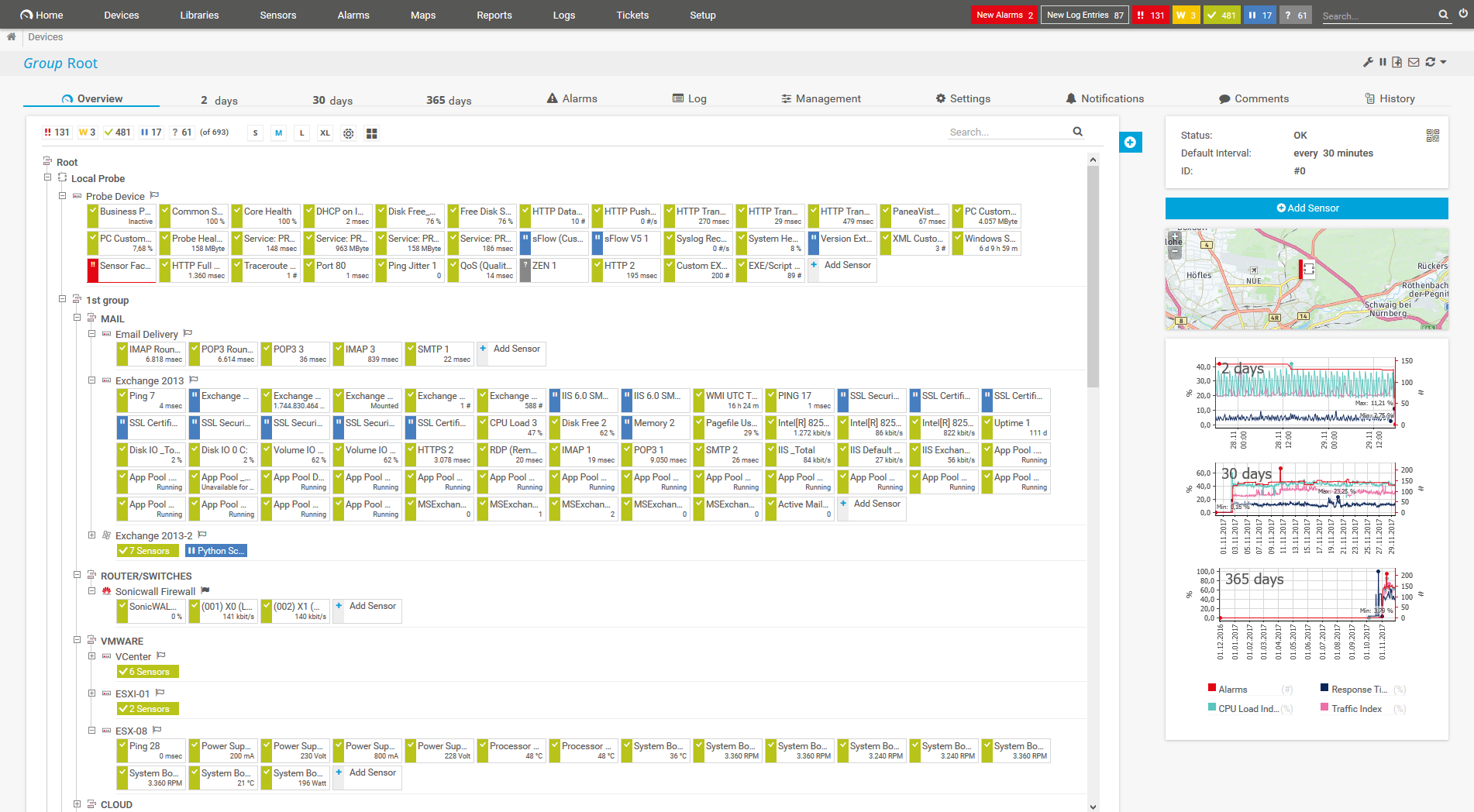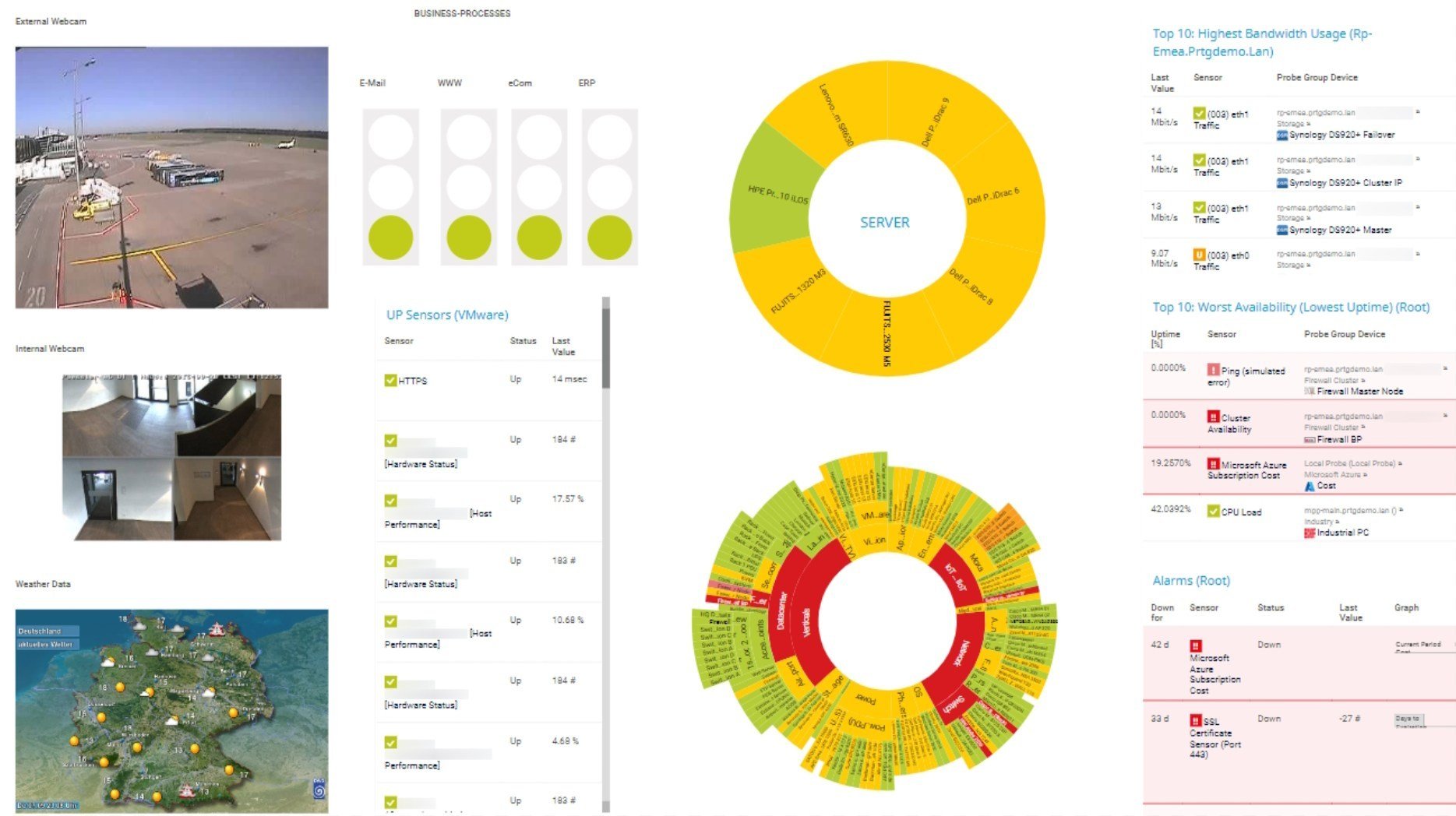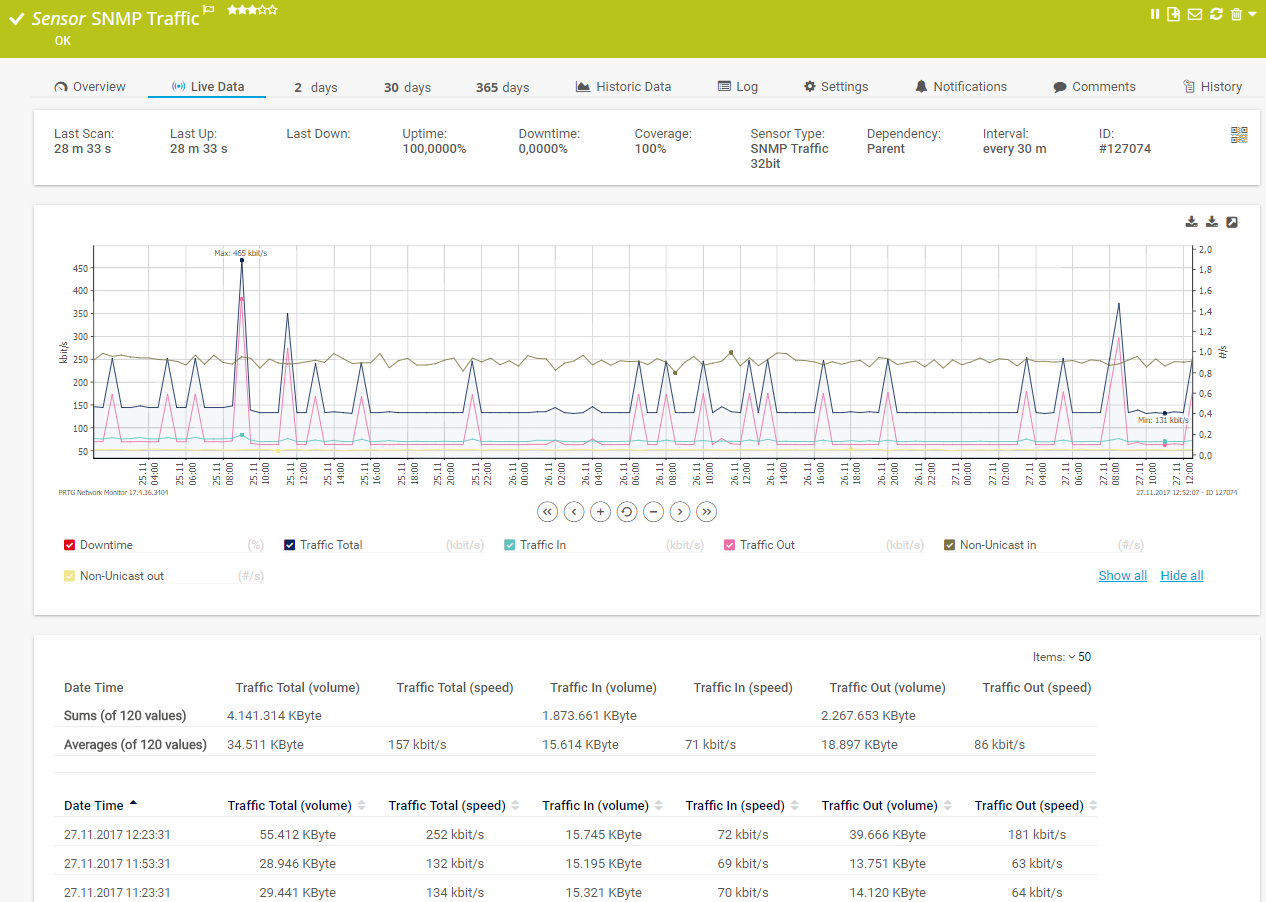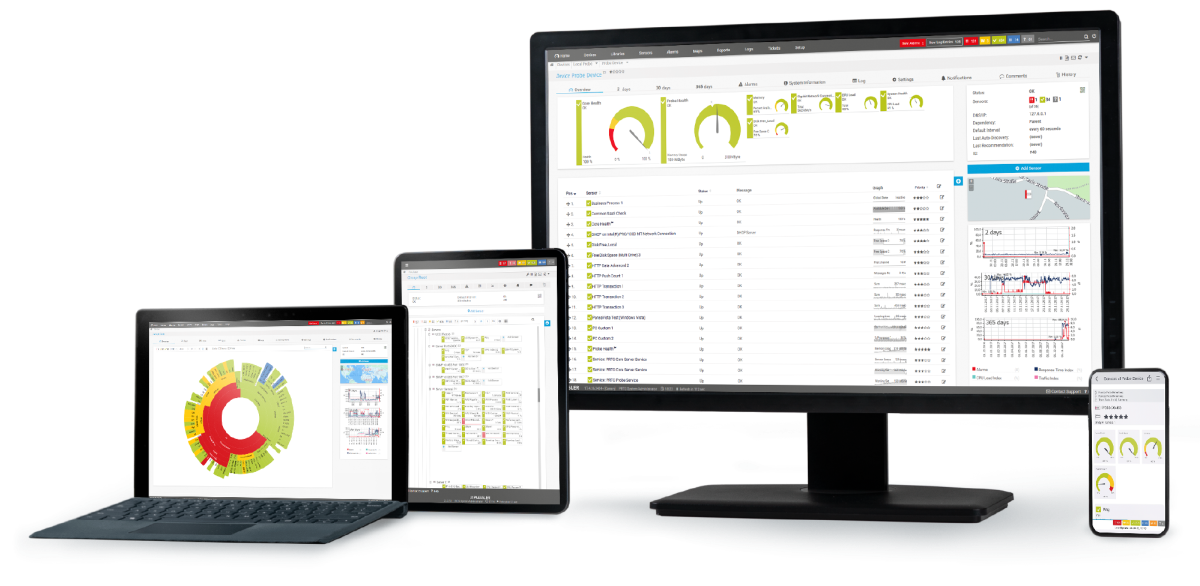Custom alerts and data visualizations let you quickly identify and prevent downtime, DNS resolution errors, and issues with DNS queries.
DNS servers are your network's postal workers.
When they're performing as they should, your data is delivered safely to its intended recipients, and everyone can get on with their work.
But if there's an error or malfunction, your data may get lost or, worse, redirected to a malicious site. Cue panicked colleagues ringing your phone off the hook.
Paessler PRTG tracks key performance statistics and alerts you if there are delays, resolution failures, and other issues. That means with our all-in-one DNS server monitoring tool, you can keep your DNS infrastructure stable and secure, your cache healthy, and everyone's to-do list on track.
Set it and forget it. Pick your preferred warning and error thresholds and PRTG will immediately notify you via the notification method of your choice if there's a risk your DNS servers might go under or if they resolve a domain name incorrectly, so you can fix errors, malfunctions, and other issues before the whole network crashes.
Watch your DNS servers like a hawk, all day, every day (even when you're away). PRTG works tirelessly in the background, monitoring DNS traffic, availability, DNS response times, and DNS performance, and making sure everything is working as it should, so you can leave the office safe in the knowledge it's all taken care of.
All your DNS server performance stats at your fingertips. PRTG saves historical data for an in-depth analysis, empowering you to allocate resources more efficiently, troubleshoot effectively, and improve security. You can even customize your dashboards easily using our drag-and-drop map editor to suit your exact requirements.
Diagnose network issues by continuously tracking your DNS services and servers. Show availability, uptime, cache status, server response time, latency, and other key metrics in real time. Visualize monitoring data in clear graphs and dashboards to identify problems more easily. Gain the overview you need to troubleshoot downtime, domain resolution errors, and other DNS server issues.

Device tree view of the complete monitoring setup

Custom PRTG dashboard for keeping an eye on the entire IT infrastructure

Live traffic data graph in PRTG
The cornerstone of PRTG's DNS monitoring capabilities is the preconfigured DNS v2 sensor:
Alongside reachability, response time, and IP address resolution failure alerts, it also monitors the number of DNS records. This enables you to see immediately if somebody has – purposely or mistakenly – accessed the DNS server and changed a record.
But PRTG doesn't stop there. Alongside the DNS servers themselves, you can also monitor the traffic on your routers and switches – two of the main causes of DNS errors and network bottlenecks.
Monitor traffic using SNMP, packet sniffing, WMI, or flow (IPFIX, NetFlow, jFlow, sFlow), and benefit from preconfigured sensors for the devices of most major manufacturers, including HPE, Cisco, and Dell.
PRTG comes with more than 250 native sensor types for monitoring your entire on-premises, cloud, and hybrid cloud environment out of the box. Check out some examples below!
See the PRTG Manual for a list of all available sensor types.
Real-time notifications mean faster troubleshooting so that you can act before more serious issues occur.
Set up PRTG in minutes and use it on almost any mobile device.

“Excellent tool for detailed monitoring. Alarms and notifications work greatly. Equipment addition is straight forward and server initial setup is very easy. ...feel safe to purchase it if you intend to monitor a large networking landscape.”
Partnering with innovative IT vendors, Paessler unleashes synergies to create
new and additional benefits for joined customers.
Paessler and Plixer provide a complete solution adding flow and metadata analysis to a powerful network monitoring tool.
IT that works constitutes a business-critical basis for a company's success. Availability and security must be defined for the respective purpose and closely monitored – by OT and IT alike.
Siemon and Paessler bring together intelligent building technology and advanced monitoring and make your vision of intelligent buildings and data centers become reality.
Custom alerts and data visualizations let you quickly identify and prevent downtime, DNS resolution errors, and issues with DNS queries.
Network Monitoring Software – Version 25.3.110.1313 (August 27, 2025)
Download for Windows and cloud-based version PRTG Hosted Monitor available
English, German, Spanish, French, Portuguese, Dutch, Russian, Japanese, and Simplified Chinese
Network devices, bandwidth, servers, applications, virtual environments, remote systems, IoT, and more
Choose the PRTG Network Monitor subscription that's best for you
DNS is short for “domain name system.” DNS (Domain Name System) records are used to map human-readable domain names to IP addresses and other information required to locate services on the internet. Here are some of the most common DNS record types:
DNS servers are also referred to as “name servers.” They assign the right IP address to a URL, and vice versa. On the web, they assign the right IP address to a domain name such as www.paessler.com so you don’t have to memorize a string of numbers. In the local network, the DNS server translates the names of computers and network devices into “real addresses.” It ensures that you can access all your devices without having to enter their IP addresses.
Active Directory also relies on information provided by the DNS. And if you wish to use the name resolution service in your own network, then you’ll need a DNS server. Without the correct DNS records, people cannot find your website or send you email. It's extremely important to know that those public records are pointing to the right addresses.
A name server is basically the same thing as a DNS server. A name server also resolves domain names to IP addresses and IP addresses to domain names. When you connect to the Internet, you access the name server of your Internet service provider. You can also set up a name server for your own network. If you do so, be sure to monitor it so you can quickly detect cyberattacks or other unwanted intrusions.
DNS servers may become unresponsive due to several reasons that proper DNS monitoring can help identify. Common causes include network connectivity issues, server overload, or configuration errors. Effective DNS monitoring can detect these problems before they escalate.
Hardware failures, DNS cache corruption, or security breaches like DDoS attacks may also cause unresponsiveness. Implementing comprehensive DNS monitoring provides early warnings about potential issues, allowing administrators to take preventive action before users experience service disruptions.
When facing DNS server issues, first implement basic troubleshooting steps while reviewing your DNS monitoring alerts for specific error indicators. Restart the DNS service or server if possible. Check network connectivity between clients and DNS servers. Verify firewall rules aren't blocking DNS traffic. Review DNS monitoring data for patterns that might reveal the root cause.
Flush the DNS cache using appropriate commands for your operating system. If these steps don't resolve the issue, your DNS monitoring system should provide diagnostic information to help identify more complex problems.
Implementing DNS monitoring with PRTG starts with adding your DNS servers as devices. Next, apply the DNS-specific sensors: DNS sensor for query monitoring and DNS v2 sensor for comprehensive server health checks. Configure DNS monitoring thresholds based on your performance requirements.
Set up notifications for critical events. PRTG's DNS monitoring capabilities include tracking response times, availability, and resolution accuracy. The dashboard provides visual representations of all key metrics, making it easy to spot potential issues before they impact users.
Because it can help you prevent potentially critical events. A DNS server malfunction could make it impossible for your colleagues to access email, applications, VoIP, and other tools they need to do their jobs, and make your network vulnerable to attacks from bad actors. PRTG alerts you before there's a risk this might happen, so you can get to the bottom of any issues and fix them straight away.
Yes. If a server forms part of your organization's infrastructure, PRTG can monitor it: application servers, backup servers, database servers, file servers, mail servers, web servers, virtual servers… you get the picture. And, with more than 250 preconfigured PRTG sensor types plus the ability to create your own custom sensors, you can keep an eye on every network variable imaginable.
In PRTG, “sensors” are the basic monitoring elements. One sensor usually monitors one measured value in your network, for example the traffic of a switch port, the CPU load of a server, or the free space on a disk drive. On average, you need about 5-10 sensors per device or one sensor per switch port.
Paessler conducted trials in over 600 IT departments worldwide to tune its network monitoring software closer to the needs of sysadmins. The result of the survey: over 95% of the participants would recommend PRTG – or already have.
Paessler PRTG is used by companies of all sizes. Sysadmins love PRTG because it makes their job a whole lot easier.
Bandwidth, servers, virtual environments, websites, VoIP services – PRTG keeps an eye on your entire network.
Everyone has different monitoring needs. That’s why we let you try PRTG for free.